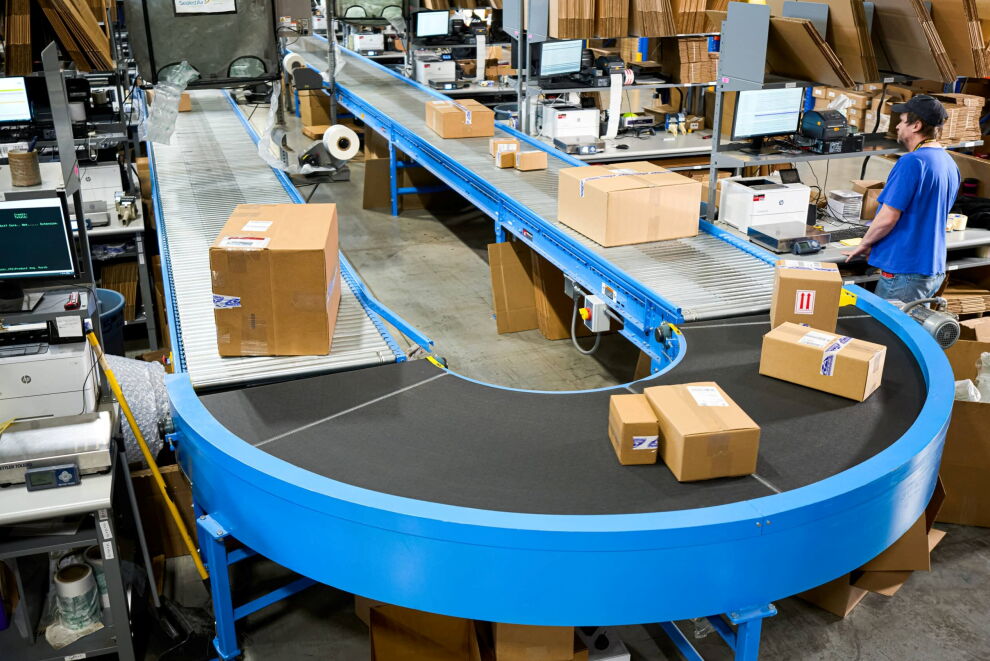Key Facts
- Automating and transporting goods in mining, manufacturing, and food processing requires conveyor belts.
- Different conveyor belts suit different operations and situations.
- Performance and safety depend on conveyor belt maintenance.
A conveyor belt’s function and definition
A rubber, fabric, or metal conveyor belt transports items around an endless loop. It moves goods along a stationary device using electric motors to drive rollers or pulleys. To suit diverse purposes, conveyor belts can be set for inclines, dips, and bends.
Types of Conveyor Belts
Different conveyor belt designs serve different industries:
Flat Belt Conveyors
The flat surface of this typical variety helps transport boxes, cartons, and other things along production lines.
Modular Belt Conveyors
Made of interconnected modules, modular belts are easy to clean and maintain, making them ideal for food preparation.
Cleated Belt Conveyors
Vertical cleats help these belts convey materials down sloped routes, increasing load capacity and reducing slippage.
Trough Belt Conveyors
Trough belts prevent bulk materials from slipping, making them ideal for mining.
Timing Belt Conveyors
Toothed belts and pulleys give timing belt conveyors exact rotation, making them vital for automobile and electronics assembly.
Industry Applications of Conveyor Belts
Belt conveyors are essential in several industries with different needs:
Mining and Quarrying
Transporting ores, rocks, and minerals over vast distances with conveyor belts increases efficiency and reduces physical work in dangerous areas.
Manufacturing
Conveyor belts coordinate component flow between workstations in production lines, decreasing delays.
Food and Beverage
Food-grade conveyor belts efficiently check and package perishable commodities while maintaining hygiene.
Logistics and Warehousing
Distribution center conveyor systems streamline sorting, scanning, and shipping.
Agriculture
Conveyor systems help farmers sort, wash, and package crops efficiently.

Advantages of Conveyor Belts
Conveyor belts improve manufacturing operations in many ways:
Precision and Efficiency
Conveyor belts provide smooth production transitions and save downtime, increasing productivity.
Operating Cost
Long-term operational costs fall with conveyor belt systems because they reduce manual labor and streamline transportation.
Reduced Risk
Automated conveyor systems reduce hard lifting and hazardous situations, lowering workplace injuries.
Enhanced Safety
Modern conveyor designs handle more materials and increase safety in diverse operational settings.
Versatility
Versatile conveyor systems, including vertical ones, maximize floor space.
Automated Processing
Conveyor belts improve productivity and reduce human error in precision-driven industries.
Maintenance and Operations Best Practices
Despite their endurance, conveyor belts need frequent maintenance for safety and performance.
Regular Inspections
Check for wear, misalignment, and belt slippage regularly to avoid costly repairs.
Cleaning
In food and pharmaceutical industries, conveyor surfaces must be clean.
Lubrication and Tensioning
To avoid damage and optimize performance, moving parts must be properly tensioned and lubricated.
Training
Operators should receive extensive instruction on emergency stops and routine safety checks.
Replacement Planning
To avoid sudden shutdowns, plan belt replacement since they have a limited lifespan.
FAQ
What is a conveyor belt?
In a production or processing setting, a conveyor belt transports goods and materials via an infinite loop of material.
How do conveyor belts boost efficiency?
Materials move faster and more efficiently with conveyor belts, increasing productivity.
In which industries are conveyor belts used?
Industries like mining, manufacturing, food processing, shipping, warehousing, and agriculture use conveyor belts.
What conveyor belt maintenance is necessary?
To prolong and optimize conveyor belt performance, regular inspections, cleaning, lubrication, operator training, and replacement planning are necessary.



